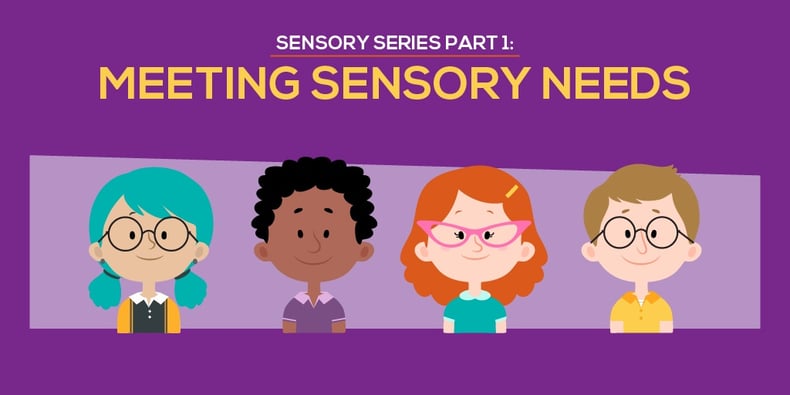
Over the past few decades, more and more information has been unpacked around the area of sensory issues with students. Some of this has come from research about the autism spectrum, while some has come from other areas of the medical field, including allergies, processing disorders, and the like.
In a classroom, it can be difficult to not only understand all of these needs, but to also help students who have them. Teachers are not medical experts by any means, but with a little background knowledge, it can be easier to understand our students and how to help them. In our three-part Sensory Series, we’ll be exploring the different ways to approach varying sensory needs.
Sensory Overview
First, let’s define what we mean when we talk about “sensory needs.” Our senses are the way in which our body processes external information. In order to learn, we see, feel, touch, and process this sensory input in order to organize our understanding of the world. In order to meet “sensory needs,” we need to consider how all of the senses are impacted.
Which students may have sensory needs? Quite a few, actually. Some students on the autism spectrum may have specific sensory issues, while others on the spectrum do not. Other students may experience Sensory Processing Disorder, which is different than autism. Some students may also have allergic reactions to environmental factors.
To further define these areas, here is a brief (and probably inadequate) piece of background on each. Please remember that this is coming from a teacher’s perspective and not a doctor’s, so there is a focus on the classroom and how these different conditions impact learning.
- Sensory Processing Disorder (SPD): A sensory processing disorder can manifest itself in a variety of ways with our students. The basic characteristic of SPD is that a student’s body will have trouble processing information, depending on which sense is being interacted with. I have had students with issues with smells in the classroom, and a teacher changing her perfume helped improve unwanted behaviors. I have also had students with the need for oral stimulation who needed a chew necklace. I have had other students who needed specific headphones to muffle auditory input in the excessively loud lunchroom.
The tricky part for a teacher can be the vastness of students who struggle with this disorder. Many times, parents understand their student best and already know to avoid certain things or provide certain accommodations. Other students may not be diagnosed yet, while some may be experiencing certain types of sensory input for the first time and are just discovering the need for support. This can seem daunting, but awareness of these conditions helps teachers to watch for and monitor them as they arise.
As a teacher, if you are needing more information or a place to start with resources, the go-to organization is the The STAR Institute. This site will help parents and educators know where to start, find resources, and network with others who may have experienced a similar journey in life.
- Autism: Most teachers probably have more experience with students with autism or autism spectrum disorder than students with SPD. There is more research on the topic and more awareness across the country for autism. Even so, it can be hard for a teacher to fully understand the condition and how it can be very different for different students.
Students with autism can often possess similar characteristics as students with SPD, but they are not the same condition. There is “overlap” between the two, but medically speaking, they are different disorders. Some of the sensory needs that autistic students have can be met through the same accommodations as students with SPD, but a student with autism can have more complicated medical issues. The spectrum of sensory needs for students with autism can run the gamut from small tactile needs to full-blown plans that implement the use of assistive technology.
For a deeper understanding with more specific information, read the National Institute of Mental Health’s outline of autism. And if there are autistic students in your classroom, this video from Sesame Street can help all the other students understand their peers. Finally, a great resource for both parents and teachers to increase understanding (and compassion) can be found at www.autismspeaks.org, a non-profit agency that promotes awareness and assists parents.
Responding With Compassion and Understanding
The key element to this information is that teachers read it with an open mind and then treat students with understanding as a result. This, of course, isn’t even 1% of the research and information available for teachers. Hopefully, this is a starting point for finding more information about the conditions that impact some of our students’ lives.
Whether you’re new to dealing with sensory issues or looking for further information and tips on how to better prepare your classroom for handling these needs, be sure to check out our three-part Sensory Series. Subscribe to the Mimio Educator blog today to be informed when the next two parts in the series are available, detailing how to design a sensory-sensitive classroom and great tech for sensory sensitivity.





